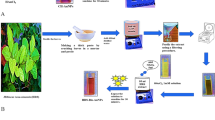Abstract
Gold ions and gold-based compounds are extremely lethal to different plant pathogens. This characteristic of gold is well known for numerous roles in the medical field as these nanoparticles have enormous surface area accessible to the microbes. In the present study, gold nanoparticles were synthesized through the bacterium, Bacillus sonorensis. Fourier Transform Infrared Spectroscopy (FTIR) analysis of the reaction mixture assisted to comprehend the nature of the biomolecules elaborate in the development of gold nanoparticles. FTIR spectrogram of the reaction mixture confirmed the existence of bands at 3700 cm−1 and 1500 cm−1, which could be assigned to N–H stretch of 1° and 2° amines, amides and C =C bending of aromatic amino acid of protein involved in reduction of Au3+ to Au0. Transmission electron microscopy was used to measure the shape and size of gold nanoparticles, which were spherical, circular and hexagonal with size ranging between 10–35 nm, indicating that the synthesized gold particles were of nano-dimensions with satisfactory level of mono-dispersity. In this study, role of gold nanoparticles in different concentrations (0, 20, 40, 60, and 80 ppm) was explored for their toxicity to six plant pathogens i.e., Dematophora necatrix, Fusarium oxysporum, Alternaria aternata, Alternaria mali, Sclerotium rolfsii and Colletotrichum capsici. Significant growth inhibition was observed in Sclerotium rolfsii at 80 ppm concentration of gold nanoparticles. Gold nanoparticles preparation (80 ppm) changed the morphology and resulted in 70% growth inhibition of Fusarium oxysporum after one week of incubation. Similarly, in case of Alternaria alernata, 60%–70% growth inhibition and change in morphology was also observed. Inhibition of Alternaria mali up to 50%–60% was observed at 60 and 80 ppm with considerable change in morphology of mycelium after one week of incubation.






Similar content being viewed by others
References
Aitken RJ, Creely KS, Tran CL (2004) Nanoparticles: an occupational hygiene review. www.hse.gov.uk/research/rrpdf/rr274.pdf. (Accessed on 03 Mar 2014).
Azam A, Ahmed F, Arshi N, Chaman M, Naqvi AH (2009) One step synthesis and characterization of gold nanoparticles and their antibacterial activities against E. coli (ATCC 25922 strain). Int J App Sci 1:1–4
Biradar D, Lingappa K (2012) Isolation and screening of gold nanoparticles by microbes. W J Sci and Tech 2:20–22
El-Batal AI, Al Tamie MSS (2015) Biosynthesis of gold nanoparticles using Marine Streptomyces cyaneus and their antimicrobial, antioxidant and antitumor (in vitro) activities. J Chem Pharm Res 7:1020–1036
Feynman RP (1959) Theres plenty of room at the bottom. Eng Sci 23:22–36
Hwang ET, Lee JH, Chae YJ, Kim YS, Kim BC, Sang BI, Gu MB (2008) Analysis of the toxic mode of action of silver nanoparticles using stress-specific bioluminescent bacteria. Small 4:746–750
Kalimuthu K, Babu RS, Venkataraman D, Mohd Band Gurunathan S (2008) Biosynthesis of silver nanocrystals by Bacillus licheniformis. Colloids Surf 65:150–153
Kim H, Kang H, Chu G, Byun H (2008) Antifungal effectiveness of nanosilver colloid against rose powdery mildew in greenhouses. Solid State Pheno 135:15–18
Li J, Li Q, Ma X, Tian B, Li T, Yu J, Dai S, Weng Y, Hua Y (2016) Biosynthesis of gold nanoparticles by the extreme bacterium Deinococcus radiodurans and an evaluation of their antibacterial properties. In J Nanomedi 11:5931–5944
Mahadevakumar S, Tejaswini GS, Janardhana GR, Vandana Y (2015) First report of Sclerotium rolfsii causing southern blight and leaf spot of common bean (Phaseolus vulgaris) in India. Plant Dis 99:1280. https://doi.org/10.1094/PDIS-01-15-0125-PDN
Morones JR, Elechiguerra LJ, Camacho A, Holt K, Kouri BJ, Ramirez TJ, Yocaman JM (2005) The bactericidal effect of silver nanoparticles. Nanotech 16:2346–2353
Nangia Y, Wangoo N, Goyal N, Shekhawat G, Suri CR (2009) A novel bacterial isolate Stenotrophomonas maltophilia as living factory for synthesis of gold nanoparticles. Microb 8:39–45
Nasrollahi A, Pourshamsian MP (2011) Antifungal activity of gold nanoparticles on some of fungi. Int J Nano Dimens 1(3):233–239
Rajathi FAA, Parthiban C, Kumar VG, Anantharaman P (2012) Biosynthesis of antibacterial gold nanoparticles using brown alga, Stoechospermum marginatum (kützing) Spectrochim. Acta A Mol Biomol Spectrosc 99:166–173
Sharma N, Pinnaka AK, Raje MA, Bhattacharyya SM, Choudhury AR (2012) Exploitation of marine bacteria for production of gold nanoparticles. Microb 11:86–92
Slawson RM, Van MI, Trevor LH (1992) Germanium and silver resistance, accumulation and toxicity in microorganisms. Plasmid 27:73–79
Thakur KR, Poonam S (2019) Nanoparticles: their synthesis and their applications. R J Biotech 14(2):92–102
Thakur KR, Shirkot P (2017) Exploration of microbial diversity of himalaya region for gold nanoparticles synthesizing bacteria. Int J Curr Microbiol App Sci 6(8):2191–2210. https://doi.org/10.20546/ijcmas.2017.608.259
Thakur KR, Shirkot P (2018a) Bioprospecting of indigenous Bacillus thuringinsis GBI-3 for extracellular biosynthesis of gold nanoparticles characterization and optimization. R J Biotech 13(12):86–96
Thakur KR, Shirkot P (2018b) Molecular identification of gold nanoparticles synthesizing bacteria through in silico methods. Int J Chem Stud 6(1):218–226
Thakur KR, Dhirta B, Shirkot P (2018) Studies on effect of gold nanoparticles on Meloidogyne incognita and tomato plants growth and development. bioRxiv. https://doi.org/10.1101/428144
Vincent JM (1947) Distortion of some fungal hyphae in presence of certain inhibitors. Nature 150:850–855
Warnock DW (1989) Methods with antifungal drugs. In: Evans EGV, Richardson MD (eds) Medical mycology a practical approach. IRL Press, pp 235–247
Zhao G, Stevens S (1998) Multiple parameters for the comprehensive evaluation of the susceptibility of Escherichia coli to the silver ion. Biometals 11:221–226
Acknowledgements
We are deeply thankful to Dr. Rajnish Sharma, Dr. Anjali Chauhan for their help and support. Both authors approve this research work and declare no conflict for authorship.
Funding
We do not get any funding from any central agency to carry out this research.
Author information
Authors and Affiliations
Corresponding author
Ethics declarations
Conflict of interest
There is no conflict between authors.
Ethical statement
No part of this research work has been published or submitted in any other journals.
Additional information
Publisher's Note
Springer Nature remains neutral with regard to jurisdictional claims in published maps and institutional affiliations.
Rights and permissions
About this article
Cite this article
Thakur, R.K., Prasad, P. Synthesis of gold nanoparticles and assessment of in vitro toxicity against plant pathogens. Indian Phytopathology 75, 101–108 (2022). https://doi.org/10.1007/s42360-021-00444-x
Received:
Revised:
Accepted:
Published:
Issue Date:
DOI: https://doi.org/10.1007/s42360-021-00444-x




